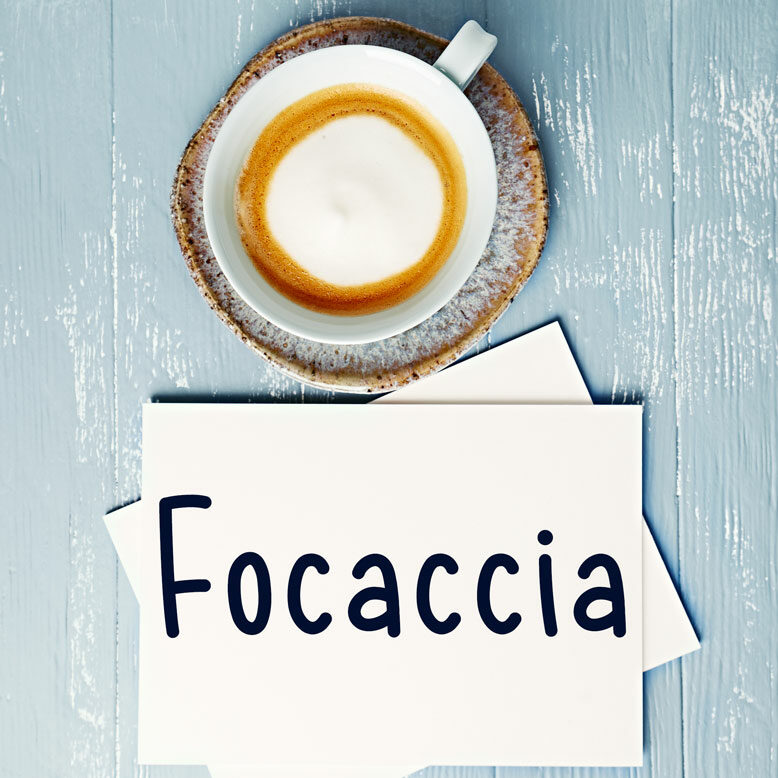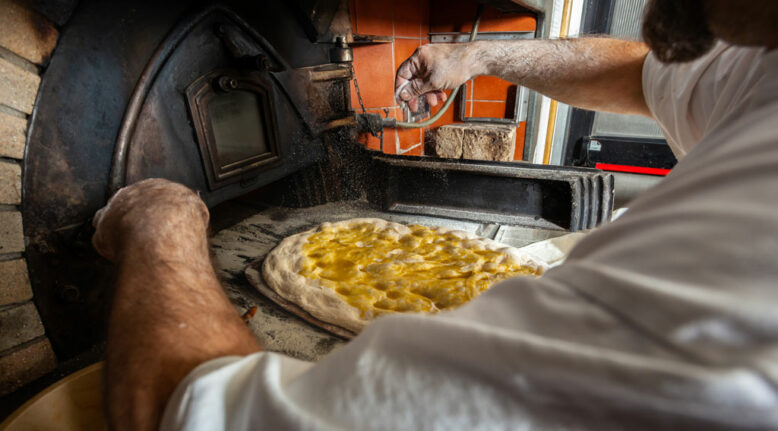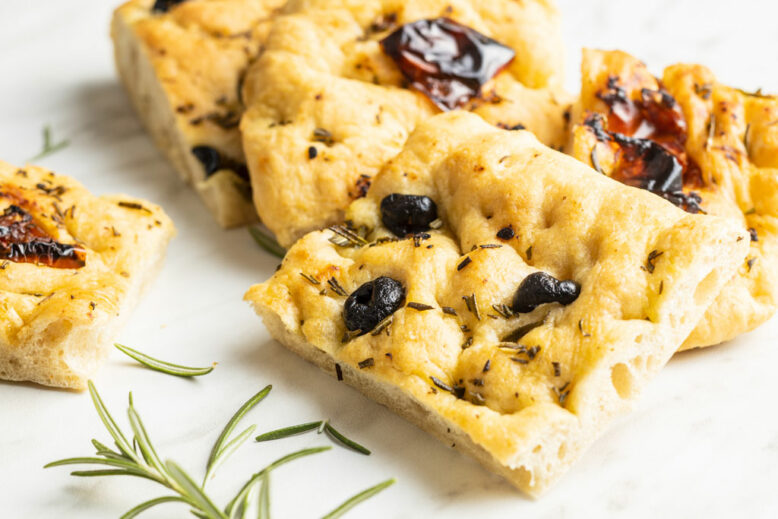Focaccia (feminine, plural: focacce) is a popular type of Italian flat bread composed of a mixture of flour, water, salt, yeast and olive oil, which can be cooked either in the oven or on the grill.
Origin of the word:
The Italian word focaccia derives from the late Latin focus which refers to cooking on the hearth. Focaccia in Latin was called focacia, the feminine of focacius.

Today it is widely associated with Liguria and the port city of Genova (where it is called fügassa in the local dialect) but it is thought that the basic recipe originated with the Etruscans.
The traditional focaccia genovese (Genoese focaccia), characterised by the holes on its surface, is brushed with olio d’oliva (olive oil), coarse sale (salt), and sometimes acqua (water) before the final rise.

In an Italian bakery, you will find various types of focaccia, from the most simple (also called focaccia bianca aka white focaccia) to the focacce farcite, which are filled with various ingredients such as ham, cheese or vegetables to name a few. Here are other popular focacce in Italy:
- focaccia barese (from Bari): the dough is made of durum wheat semolina, wheat flour, yeast, water, oil and salt, to which you add olives and cherry tomatoes
- focaccia pugliese (Puglia region): similar to the focaccia barese when it comes to the basic ingredients, but much softer (the ‘barese’ is thinner and crispier), and seasoned with cherry tomatoes, oregano and olive oil
- focaccia romana (Rome): white focaccia stuffed with mortadella, or prosciutto and figs
- focaccia di patate: potato focaccia, where potatoes are used for the dough and seasoning
- focaccia con cipolle: seasoned with onions
- focaccia rossa: literally ‘red focaccia’, with tomato sauce and various optional ingredients such as cheese, vegetables, olives, etc.
- schiacciata: type of flat bread made with flour, water, yeast, salt and olive oil. Similar to the focaccia genovese but quicker to make. Schiacciata means pressed, from the verb schiacciare, and refers to the action of the baker pressing down on the dough with his fingers rather than using a rolling pin.

How do you pronounce ‘focaccia’ in Italian?
The truth is that the Italian pronunciation of focaccia isn’t all that different from the English pronunciation, but there are a couple of key things to be aware of:
In English, we tend to replace the o and ia vowel sounds with the relaxed ə sound (close to an ‘uh’), but in Italian, you must clearly pronounce each vowel.
Don’t be in a hurry when pronouncing the double cc. Like all double consonants in Italian, it is pronounced with a longer sound than a single consonant. Simply hold the position of your mouth when the consonant is formed for a brief second, then release.
<< FOCACCIA >>
/fo’katː∫a/
Preferisci la focaccia o la pizza?
Do you prefer focaccia or pizza?

The idiomatic expression rendere pan per focaccia (lit: to give back bread for focaccia) means to take revenge on someone for an offence by doing something similar in return, much like the English expressions tit for tat or an eye for an eye.
Did you know…?
Focaccia is also the name for traditional sweet desserts, whose ingredients vary from region to region. The focaccia veneziana (Venetian focaccia) is another name for Veneziana dolce (lit: sweet Venetian), a special type of panettone, the Italian Christmas cake.
Heather Broster is a graduate with honours in linguistics from the University of Western Ontario. She is an aspiring polyglot, proficient in English and Italian, as well as Japanese, Welsh, and French to varying degrees of fluency. Originally from Toronto, Heather has resided in various countries, notably Italy for a period of six years. Her primary focus lies in the fields of language acquisition, education, and bilingual instruction.


